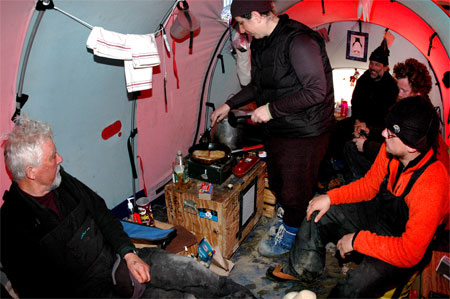|
'Ice People'Aghion documentary evokes the majesty of AntarcticaPosted January 9, 2009
Filmmaker Anne Aghion’s latest documentary has already hit a few of the world’s cultural capitals since premiering last year — New York, Paris, San Francisco and McMurdo Station McMurdo Station? Yes: One of the first audiences to see “Ice People” Aghion, speaking by phone from New York a few days before the film was to run in Antarctica, sounded anxious about the reception it might receive, despite a long list of praise the documentary had already gotten in the media. “I’m quite anxious. I’m curious to hear what people think down there,” said Aghion, who received an Antarctic Artists and Writers Program Aghion and her film crew — Sylvestre Guidi, director of photography, and Richard Fleming, sound recordist — spent about four months in Antarctica to create the documentary. About half the time involved living and working alongside a small team of scientists led by Ashworth and Lewis in a field camp in the McMurdo Dry Valleys The researchers, both now professors at North Dakota State University But discovery is secondary to experience in Aghion’s film. “It’s really a film about the experience of spending time in Antarctica, and also about the experience of doing this kind of work,” she explained. “It’s a film where I take you on a journey to Antarctica. I want you to feel the cold. I want you to hear the wind and hear the silence.” Back in Antarctic for additional fieldwork with Lewis, Ashworth said via e-mail that he knew the documentary would focus on life in the extreme after first meeting Aghion. “The cinematography of the landscapes is spectacular, and combined with the music, helps to capture the vastness and scale of Antarctic landscapes, which are like no where else on Earth,” he said. “She also captured the spirit of what makes us tick — which is the thrill of discovery and trying to explain what it all means,” Ashworth added. “She contrasted those aspects of our lives to the difficulties of working in environments of extreme cold — the grind of daily work — dealing with the grittiness of camp life — the grime of not washing for weeks on end and conversations with colleagues that go around and around.” An Emmy-award-winning documentarian, Aghion described the audience reaction to the screening at the Walter Reade Theatre in New York. When the lights went back on, everyone was still, quiet, she said, as each one adjusted as if returning from a long journey. “I felt like saying, ‘welcome home.’ The film takes you really far away,” she said. “I’m actually very happy with the film. I think it’s very close to my original intention.” The film was somewhat of a departure from her recent work, which has focused on post-genocide Rwanda with a pair of films Aghion is also busy promoting “Ice People,” which will open the Fargo Film Festival Ashworth said he hopes the film will break the stereotype of scientists “as remote and egg-headed. “I hope people get a sense that scientists are regular people even though driven by different passions than plumbers, bankers, lawyers or doctors,” he added. “I hope that some young viewers might find the prospect of studying science exciting enough to pursue it later in life.” What’s next for Aghion? She is characteristically vague on that question, though admitted she would be keen to return to Antarctica in the deep of winter some day. “I’d like to stay involved with Antarctica,” she said. “It would be a fun project to do.” NSF-funded work in this project: Anne Aghion, Antarctic Artists and Writers Program, Award No. 0537954 |



For USAP Participants |
For The Public |
For Researchers and EducatorsContact UsU.S. National Science FoundationOffice of Polar Programs Geosciences Directorate 2415 Eisenhower Avenue, Suite W7100 Alexandria, VA 22314 Sign up for the NSF Office of Polar Programs newsletter and events. Feedback Form |


